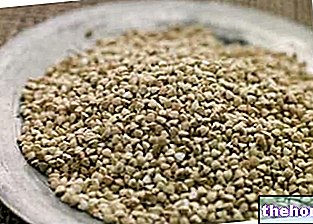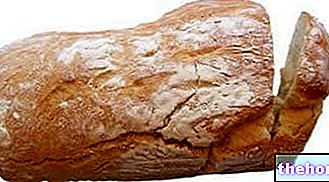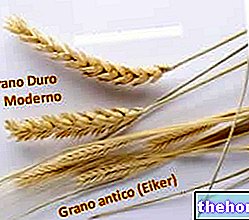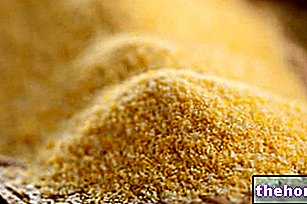Burnt wheat flour is a product obtained from the roasting of durum wheat (Tritucum durum), followed by grinding the seeds until they are reduced to a coarse powder, called "burnt wheat flour".

Birth of the Burnt Wheat
Typically Apulian (Foggia and north-Bari), burnt wheat was born from the need to recover the ears of wheat fallen to the ground and hidden by the vegetative portion of the plants following harvesting. This recovery, as can be deduced, is particularly difficult to carry out with the stubble intact; therefore, also by virtue of the fact that burning the straw favors the fertilization of the soil, the harvest of burnt wheat was carried out only at the end of the combustion of the fields In this way, farmers were able to obtain seeds without having to buy a large "slice" of the crop (owned by the landowners and too expensive for their pockets), while contenting themselves with what the flames left to the ground. This wheat was then ground to obtain a typically wholemeal flour.
Burnt Wheat and Flour: Today
Today, gano arso is produced in a completely different way. In practice, the wheat is destined for a simple roasting, similar to the roasting of coffee, which gives it hints of "cooked" and "smoked". This last discrepancy between the two wheats is nothing short of essential, since the "original" burnt wheat underwent a partial carbonization externally, even if for some authors the ears would be able to protect the grains to the point of leaving them totally intact. , today's (controlled) roasting takes place with shelled seeds and guarantees a different activation of the Maillard reactions. It may seem paradoxical but, according to what the experts say, the burnt wheat produced with modern technologies has a more intense aroma and taste and, used pure, has a lower approval rating than the traditional one.
In today's times, burnt wheat (which we remember being whole) is a niche food, sought after and very particular; is found with some difficulty and, more frequently, relying on suppliers of organic and traditional food. Available almost exclusively in the form of flour, it has a fairly high cost (obviously unjustified) and, even through the internet, it can be purchased directly from the artisan mills that produce it. The cost is close to 5 € / kg.
Purpose and Characteristics of Arso Wheat Flour
Burnt wheat flour is useful for making alternative recipes. It is possible to use it in the production of pasta and bakery products, especially in a mixture with raw wheat flour. This expedient has not ONLY organoleptic and gustatory bases, but also chemical-physical bases.
As many readers will already know, the "key" to a correct leavening of the bread and the resistance to cooking of the dough lies in the presence (and activation) of two particular peptides contained in some cereals (wheat, spelled, rye, etc.). These peptides, hydrating, combine and form an elastic network that traps the air in the bread, inflating the dough, while in the dough it protects the starch by regulating its gelatinization. We are talking about peptides. gliadin And glutenin, which, in the presence of water, give rise to gluten. Burnt wheat flour, being made from wheat, contains both peptides but, after heat treatment, a large part of these denatures and no longer performs its function correctly. This does not exempt this flour from its "harmful" potential towards gluten intolerant people, that is celiacs, but it decisively compromises the quality of the doughs obtained from it.
In bread making, burnt wheat flour should never be present in quantities greater than 30%, where the remaining 70% is based on raw wheat flour. On the contrary, in the formulation of pasta, burnt wheat flour can also play a role of greater importance, but this does not mean that the rheological properties of the food are different from traditional ones. In fact, pasta with only burnt wheat flour absorbs more water during cooking, becoming more sticky and less consistent. In general, the pasta obtained with burnt wheat flour is fresh, not dried, and is mainly available in the form of "cicatelli"; however, today they are also available pasta with mixed content that imply the use of burnt wheat flour mixed with the normal one. To obtain an alternative pasta with the same characteristics as the traditional one, it is recommended NOT to exceed 20% of burnt wheat flour, especially if you choose to make a mixture with the addition of eggs.
Generally, compared to traditional white flour, that of burnt wheat has a higher protein content (but it is not possible to establish the gluten index, for the reasons explained above), a higher content in ash (mineral salts), a higher content in carbohydrates seeds -fragmented, a lower pH and less water.
Homemade orecchiette with burnt wheat flour
Homemade Orecchiette
Problems with playing the video? Reload the video from youtube.
- Go to the Video Page
- Go to the Video Recipes Section
- Watch the video on youtube
Other Cereals and Derivatives Amaranth Wheat starch Corn starch Rice starch Modified starch Oat starch Bulgur Whole grains Corn Flakes Crackers Oat bran Bran Cus cus Amaranth flour Oat flour Buratto flour Spelled flour Buckwheat flour Corn flour Corn flour Millet Barley flour Quinoa flour Small spelled flour (Enkir) Rice flour Rye flour Sorghum flour Flour and semolina Whole wheat flour Manitoba flour Pizza flour Spelled Rusks Focaccia Nuts Wheat or wheat Wheat germ Burnt wheat Buckwheat Breadsticks Oat milk Rice milk Corn Maizena Malt Millet Muesli Barley Stale bread Unleavened bread and Pita Bread Carasau bread Egg pasta Rice pasta Wholemeal pasta Piadina Small spelled Pizza Pop corn Baked goods Quinoa Rice Basmati rice Converted rice White rice Rice Wholemeal Parboiled Rice Puffed Rice Venus Rice Rye and Horned Rye Semolina Semolina Sorghum Spaghetti Spelled Teff Tigelle Triticale OTHER ARTICLES CEREALS AND DERIVATIVES Categories Food Alcoholics Meat Cereals and derivatives Sweeteners Sweets Offal Fruit Dried fruit Milk and derivatives Legumes Oils and fats Fish and fishery products Salami Spices Vegetables Health recipes Appetizers Bread, Pizza and Brioche First courses Second courses Vegetables and Salads Sweets and Desserts Ice creams and sorbets Syrups, liqueurs and grappas Basic Preparations ---- In the Kitchen with Leftovers Carnival Recipes Christmas Recipes Dietary Recipes Light Recipes Woman's Day, Mother's Day, Dad's Day Functional Recipes International Recipes Easter Recipes Recipes for Celiacs Recipes for Diabetics Holiday Recipes Valentine's Day Recipes Vegetarian Recipes Protein Recipes Regional Recipes Vegan Recipes
















.jpg)











